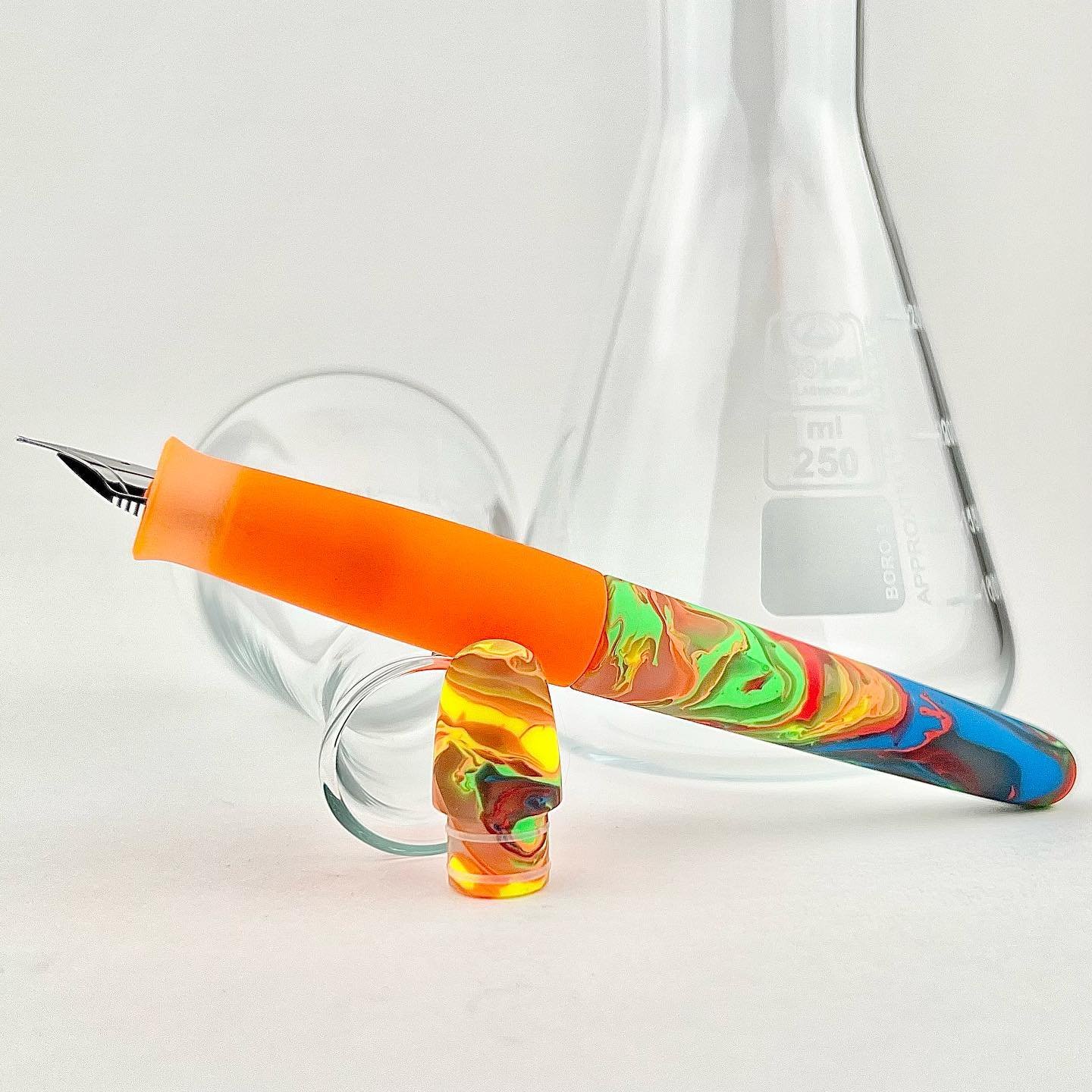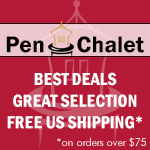Sean Alott, London Pen Co. (center,) flanked by Jon Tello (left,) and Jonathon Brooks.
(Caroline Foty's first fountain pen was a 1970s Sheaffer No Nonsense that still writes perfectly. Since she discovered pens by independent makers, she wants "one of each, please" and wants to meet all the makers. Maybe you do, too. She lives in Baltimore with pens, cats, and all kinds of fiber arts supplies.)
Sean Allott’s first pens were made for his dad, but there was nothing sentimental about his decision to start a pen company. The analytic bent required to manage an IT consulting company came in handy at this turning point in his business.
After attending a wood show and seeing someone turning pens, he bought a desktop lathe driven by an electric drill. From there he took courses in wood turning of bowls, vases, and boxes (his favorite), gradually upgrading his lathes to match his aspirations (a variable speed drill! clamps!) until he arrived at the CNC setup he now runs.
Allott began making kit pens for his father, “the pen guy” in the family, and took a course at Lee Valley Tools to learn how to finish them properly. (He still makes kit pens, finding them a good teaching project.) Then, in 2015 he found the London (Ontario) Pen club, and began learning to make kitless pens. He attended his first show, Scriptus, in Toronto in 2019, with his first model, the Parnell, and considered it partly a test to see if launching a pen company made sense. A quick analysis of the demographics of show attendees convinced him to go forward.
“The customers at the show were predominantly younger, and mostly women – this was going to be a growing audience for pens.”
C14 Azalea.
Just a few months later, COVID shutdowns happened, so he was stuck at home with some spare time – the IT company required less of his energy because “customer acquisition was just not happening.” He began working almost full-time on his pens, developing his flagship model, the Christopher, named after his late father. In 2021, he launched his website, because he could not keep up with sales volume using Instagram as a platform. He currently has four main models, plus several variations on the Christopher, and his earliest models the Parnell and Ritchie are being redesigned.
Nona14 Long Argent Sapphire.
While he has cast some of his own materials, currently his equipment for this is still not unpacked from moving his shop when he took his IT company out of its large space into a smaller one. He plans to get back into it, though, because it’s one way to make his pens unique.
Allott finds the CNC processes to be so complex and interesting that he asks, “Did I actually get into penmaking to learn CNC?” When designing a pen, he makes his first examples by hand on the wood lathe, working on it till he’s satisfied and then converting it to CNC tool paths. The biggest challenge has been learning to do the 3D drawing necessary to bring a design to CNC. “You’re essentially doing three people’s jobs” to make a product using CNC. It’s more difficult to get the design produced by CNC, but the payback comes with the ability to produce that design in volume.
Nona14 Omas Black White Swirl.
The sanding, polishing, and finishing still has to be done by hand and takes more than fifty percent of the total time to make a single pen; more than fifty percent in the case of the faceted Nona model, with which he has a “love-hate” relationship. Available methods for automating some of the finishing are unsatisfactory for alumilite resin, which is too soft for any kind of automated tumbling. And finish is too important to take shortcuts. “The finish in a pen is how you can tell how long the maker has been doing it.” He recalls buying a pen from Brad Owens of Mythic Pens and thinking, “Ok I have to up my finishing game!” He has many pens sitting in his shop that have flaws in the material or the making, that will never be sold.
C14, Faceted Cap, Water Liliy Koi.
The materials are a large part of what keeps penmaking interesting for Allott. “I’m a material addict!” Wood turners can get tired of making pens because for them the process itself is simple, but with so many makers creating so many beautiful materials, he never gets tired of it. “Making a product people enjoy is extremely satisfying and rewarding in itself.”
Despite being “not much of a pen user – my handwriting and drawing are horrible” – Allott has a Shawn Newton pen he particularly likes, and a limited edition pen purchased from Jon Tello of Hello Tello. He’s also continuing to grow his collection of pens from independent makers. To use his pens more, he hopes to learn to draw as well as to paint in watercolors, and learn about different nib grinds and what they can be used for.
In 2023, Allott has attended a couple of US pen shows as an experiment to see how successful they would be for him. It is only coincidence that this article is appearing in the same month as the infamous Orlando Pen Show incident, wherein UPS was unable to move his inventory from South Carolina (where Jonathon Brooks was keeping it for him after the DC show) to Florida in anything like the promised two days. The London Pen Company table in Orlando had no pens on it, and he credits the other makers in attendance with keeping his spirits up, as well as promoting the successful online pen show he conducted on YouTube when his inventory made its way back to his home. “I love the people in this community, both makers and customers – they’re fun people. Even though I had NO PENS in Orlando, it was a great experience.”
C13 Cool Tone PM.
Allott has enough plans to keep him energized for the foreseeable future. He’s been reinvesting some of his pen making income in materials and equipment for metal casting, and hopes to be producing silver roll stops, bands, and clips by the end of 2024. To do this, he’ll need to learn more skill at drawing in 3D, and will be taking some online classes in 3D drawing for jewelers using software. He’s also learning laser engraving to enable him to embellish nibs and create finial coins. And he’s learning the ornamental lathe or rose engine – it is usually used to decorate wooden boxes but will allow him to engrave patterns on pens and maybe even try guilloche. In thinking about retirement, he envisions perhaps making fewer pens, but more complex ones that are more like functional art, and turning boxes for storing pens and inks. “The future is wide open, but the next couple of years will be for fun and experimenting.”
Sean Allott’s work can be seen on Instagram @londonpenco, his website London Pen Co., and at shows in Toronto and Washington DC.
Enjoy reading The Pen Addict? Then consider becoming a member to receive additional weekly content, giveaways, and discounts in The Pen Addict shop. Plus, you support me and the site directly, for which I am very grateful.
Membership starts at just $5/month, with a discounted annual option available. To find out more about membership click here and join us!
























